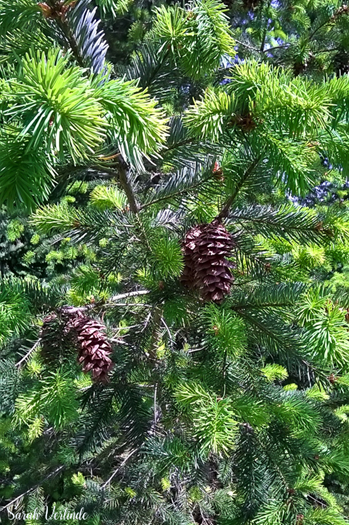Douglas-fir
Pseudotsuga menziesii var. menziesii – Douglas-fir
At a Glance:

- Family: Pinaceae
- Plant Type: Tall erect evergreen tree
- Distribution: Western half of North America including some eastern states.
- Habitat: Moist to dry areas and low and mid-elevations.
- Height: up to 90m tall
- Cones: Female comes are green to woody-red brown as they develop, up to 10cm long. Male comes are up to 1cm and yellow to red in color.
- Cones Season: April – May
- Leaves: Needles are 2-3cm long, two white stripes on the underside, dark green and glossy on the top side. Arranged spirally like a bottle-brush around branch.
- Generation: Perennial
- Bark: dark brown, rough, and very thick.
- Notable feature: Needles arranged spirally around branch and are soft to touch. The Sitka Spruce (Picea sitchensis) can look similar, but have stiff needles that are very pointy and can hurt when you touch them.
Restoration and Conservation
Douglas-fir is a fixture in many forests across the Pacific Northwest. The thick bark of the Douglas-fir make them fire resistant to moderate surface fires. The cones and needles provide a large portion of the blue grouse’s winter diet. The foliage and twigs are also eaten by deer, elk and mountain sheep. It is not a true fir tree, which is why we hyphenate the name: Douglas-fir.
Ethnobotany
Douglas-fir wood was regarded as an optimal fuel source by many coastal tribes. The wood was also used to create spear handles, dip-net poles, harpoon parts and other items. The pitch was used for torches as well as being used as a medicinal salve. The pitch was also used to help make containers water-tight. Douglas-fir needles were brewed into a medicinal tea to treat joint pain. Douglas-fir is used commercially as well, its wood is often used to make telephone poles and they are a popular species grown for Christmas trees.
References and Resources
- Pojar, J and MacKinnon, A. 2004. Plants of the Pacific Northwest Coast: Washington, Oregon, British Columbia and Alaska. Vancouver (BC): Lone Pine Publishing.
- USDA: https://plants.usda.gov/plantguide/pdf/cs_psme.pdf
- WTU Image Herbarium: http://biology.burke.washington.edu/herbarium/imagecollection/results.php?Genus=pseudotsuga&Synonyms=Y
This article was written by Jessica Rouske and Sarah Verlinde. For questions regarding the UWB/CC Plant Tour, contact Sarah at severlin@uw.edu.
